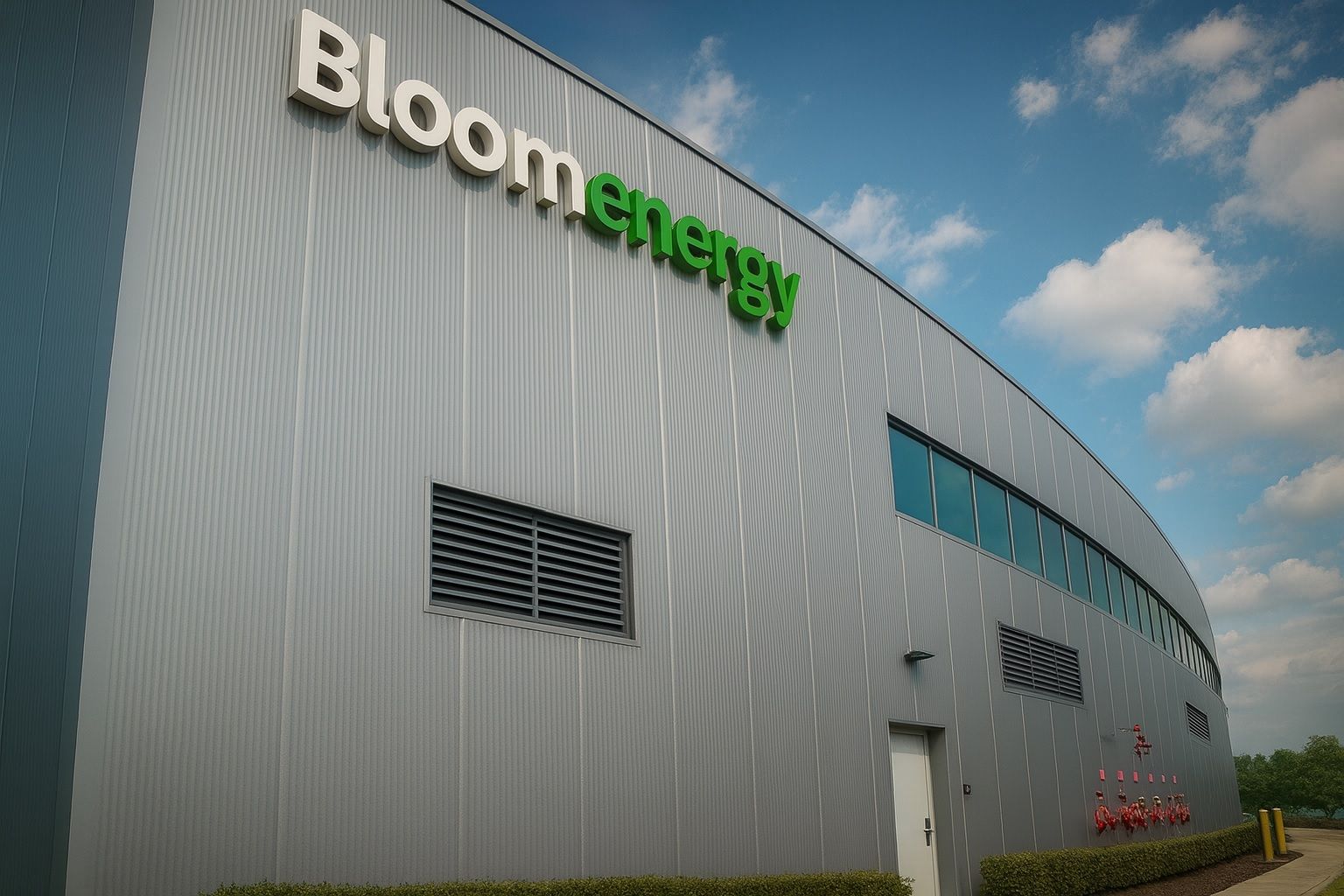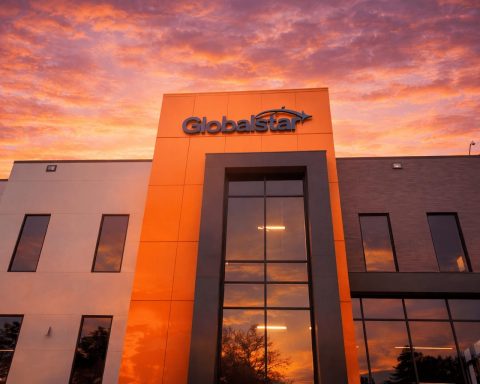- $5B Partnership: Brookfield Asset Management will invest up to $5 billion to deploy Bloom Energy’s solid-oxide fuel-cell systems in next-generation AI data centers worldwide [1]. The deal – the first under Brookfield’s new “AI Infrastructure” fund – kicks off a joint vision to build integrated “AI factories” (compute+power facilities) at massive scale [2] [3].
- AI “Factories”: Under the agreement, the two companies will co-design these AI-optimized data centers globally (including a European site announced by year-end) [4]. AI compute workloads require huge, on-site power – far beyond normal grid capacity – so Bloom’s fuel cells (which run on natural gas, hydrogen or biogas) will provide clean, rapid-response electricity right at the data center [5] [6].
- Stock Surge: News of the partnership sent Bloom Energy shares through the roof. On Oct. 13, BE jumped roughly 25–30% to a record high (around $108 per share) [7] [8], adding about $6–7 billion to its market cap. BE’s market value is now on the order of $20 billion [9] – roughly 7× what it was last year – after a jaw-dropping ~700% climb so far in 2025 [10] [11].
- Fuel-Cell Edge: Bloom’s SOFC fuel cells generate electricity electrochemically (not by burning fuel), giving them much higher efficiency and far lower emissions than conventional generators [12]. They can be deployed in modular skids in ~90 days and use waste heat for extra power (efficiency ~85–90% vs ~54% without heat recovery) [13]. This makes them ideal for AI centers, which have “spiky” power loads (demand can jump by 50–100 MW in seconds) that legacy grids can’t handle [14] [15]. Importantly, Bloom’s SOFCs emit virtually no NOₓ, SOₓ or VOC pollutants because of their low-temperature chemistry [16] – they run quietly on-site like an efficient microgrid. Bloom notes its systems already power over 400 MW of critical data center load globally [17].
- Exploding Demand: Experts warn AI will drive enormous electricity demand. U.S. AI data centers alone could require 100+ gigawatts of power by 2035 [18] [19] – roughly the output of a hundred big nuclear plants – up from only ~10 GW today. S&P Global projects U.S. data-center power use will rise ~12% per year through 2030 [20]. This “AI power crunch” is a major reason Brookfield is backing on-site solutions now, and explains why fuel cells have become a hot option.
- Analyst Optimism: Wall Street quickly turned bullish. Susquehanna and UBS raised BE price targets to the mid-$100s [21], citing the deal. Morgan Stanley (Overweight, $85 PT) and Wells Fargo ($65) also bumped forecasts, all noting huge future AI-related sales [22]. In fact, some modeling suggests Bloom’s revenues could leap 30–50% in 2026 if even a fraction of Brookfield’s $5B is deployed promptly [23]. Before this news, consensus targets had been only ~$80–90 [24], so analysts are scrambling to catch up.
- Expert Endorsements: Bloom’s CEO KR Sridhar hailed the tie-up: “AI factories demand massive power… that legacy grids cannot support,” he said, calling the deal a blueprint for “powering AI at scale” [25]. Brookfield’s AI chief Sikander Rashid likewise stressed that Bloom’s “behind-the-meter” fuel cells add “a powerful new tool” for closing the grid gap and enabling these facilities [26]. TS2.tech reports Microsoft even tested a 3 MW hydrogen fuel-cell backup in one data center to replace diesel generators – underscoring the industry’s shift to zero-emission power [27].
- Fuel-Cell Frenzy: Bloom’s rally is part of a broader green-energy boom. Plug Power stock jumped ~170% this month on a bullish upgrade, and Ballard Power was up ~23%, as investors chase hydrogen/fuel-cell plays [28]. However, analysts caution Bloom remains a growth company (it only briefly turned GAAP-profitable in Q2 2025) [29], so earnings depend on execution of these large projects. BE now trades around 11–12× sales [30], so any profit-taking or disappointment could cause pullbacks.
Brookfield’s AI Infrastructure Bet
On Oct. 13 (market hours), Bloom and Brookfield jointly announced the partnership via BusinessWire and press reports [31]. Under the agreement, Brookfield (a $1+ trillion asset manager) commits up to $5 billion to fund Bloom’s fuel cells at AI data centers worldwide [32] [33]. Bloom becomes Brookfield’s preferred on-site power provider for its new “AI factories” – purpose-built data centers where power and compute are designed in concert [34] [35]. A spokesperson confirmed the first European AI factory site will be announced by year-end [36] [37].
Brookfield’s dedicated AI Infrastructure strategy already includes multi-billion dollar data-center and clean-power initiatives in Sweden and France. CEO Rashid noted that now Bloom’s fuel cells give Brookfield “the unique capability to design and construct modern AI factories with a holistic… approach to power needs” [38]. The core idea is that AI centers must operate like factories – requiring “purpose, speed, and scale” – so on-site solutions like fuel cells and modular generators will be essential to meet surging demand [39] [40]. The deal thus signals a pivot away from relying on strained public grids toward clean, dispatchable power sources.
According to the companies, electricity demand from U.S. AI data centers could top 100 GW by 2035 [41] [42]. This looming shortfall is driving tech giants to seek new power solutions. Bloom has already deployed hundreds of megawatts of SOFC capacity for hyperscale clients (American Electric Power, Equinix, Oracle, etc.) [43] [44], and the Brookfield pact will scale those efforts globally. In fact, DatacenterDynamics notes Bloom signed a direct supply deal with Oracle in July, plus multi-site agreements with Equinix (~100+ MW) and AEP (up to 1 GW) [45]. Bloom is now expanding production – it plans to double its factory output from ~1 GW/year to 2 GW/year by end-2026 [46] to meet surging orders.
Fuel Cells Power the AI Data Center Revolution
Why fuel cells? Unlike combustion turbines, Bloom’s solid-oxide fuel cells convert fuel into electricity chemically, yielding much higher efficiency and virtually no pollutants [47] [48]. They can run on multiple fuels (natural gas, biogas or hydrogen) and produce only water and heat. Because SOFCs operate at relatively low temperatures, they emit almost no NOₓ or SOₓ and no volatile organic compounds [49]. In practice, this means a fuel-cell bank next to a data center can operate 24/7, “load-following” the computers, and even feed waste heat into cooling systems for extra efficiency [50] [51].
Critically, fuel cells respond instantly to power swings. Bloom’s engineers report that AI workloads can spike a server’s power draw from 20% to 150% within seconds [52]. Traditional grids struggle with such volatility, often relying on batteries (which have limited cycles) or diesel backups. Bloom notes that pairing its fuel cells with supercapacitors handles millions of cycles with 99.9% availability [53]. Fuel cells can be deployed in modular skid units (pre-fab “racks” of cells) that bolt on-site in a few months [54], far faster than building new transmission lines. In short, analysts say Bloom’s clean, on-site plants are well-suited to the “spiky” loads of AI [55].
The partnership press materials emphasize this point. As Sridhar puts it, “the lean AI factory is achieved with power, infrastructure, and compute designed in sync from day one” [56] [57]. Brookfield’s Rashid adds that behind-the-meter solutions like fuel cells are “essential to closing the grid gap” for these new data centers [58]. In plain terms: as data-center operators race to expand for AI (e.g. Amazon’s $10B Mississippi project or Meta’s planned 5 GW Louisiana center [59]), they’re embracing non-traditional power sources. Fuel cells, with their low emissions and quick build, fit the bill.
Bloom’s Stock Rally and Market Reaction
Wall Street reacted with euphoria. On Oct. 13, BE stock leapt from about $87 to ~$110 in premarket trading – roughly a +27% surge [60]. By market open it had risen ~25% to a record $108.17 [61], making BE one of the day’s top gainers on the NYSE. (Some outlets even reported intraday jumps near 30–35% [62].) The rally added roughly $6–7 billion in value – Bloom’s market cap is now ~$20 billion [63], up dramatically from under $3B a year ago. Remarkably, Bloom has nearly quintupled year-to-date (up ~700% since Jan. 1, 2025 [64]), reflecting growing investor belief that AI and clean power can reshape the company’s fortunes.
Analysts quickly revisited their models. Several firms raised their price targets on Bloom after the announcement [65]. For example, Susquehanna and UBS both set new targets around $100–105 [66] (up from mid-$50s before the deal), while Morgan Stanley ($85) and Wells Fargo ($65) likewise lifted forecasts on the expected AI/clean-energy boom [67]. As TS2.tech notes, Evercore ISI had just initiated coverage with a $100 target (an Outperform) right before news broke [68], and that level may be easily surpassed given the enthusiasm. In fact, some bullish models suggest Bloom’s 2026 revenue could jump 30–50% if even part of Brookfield’s $5B is invested next year [69].
However, the valuation is now very rich. BE’s price-to-sales ratio stands around 12× forward revenues [70] – far above most legacy industrials. Analysts warn that any profit-taking or execution hiccups could send the stock swinging. TS2.tech points out that BE fell from $77 to $61 in late Sept (down ~20%) just before this rally, reflecting volatile sentiment [71]. Some traders are tempering expectations: “anything attached to AI is garnering a significant amount of attention,” notes Bill Merz of U.S. Bank Wealth Management [72], implying that hype can overheat. A Bloomberg economist, Niklas Larsen, even observes that surging gold and yen prices mean there’s “a lot of nervousness” out there [73].
In summary, the stock now sits well above pre-deal consensus (many targets were in the $80–90s [74]). If Brookfield actually orders large volumes of fuel cells, some say BE could still be undervalued; but if those orders disappoint or production bottlenecks arise, profit-taking may follow. As one TS2 analyst puts it, a cautious investor might “wait for the dust to settle… and a revised guidance,” while a bullish one sees the rally as potentially justified by Bloom’s strategic position [75] [76]. Either way, everyone agrees Bloom is firmly on the map for AI infrastructure.
Analysts’ Forecasts & Bottom Line
Looking ahead, investors will be watching for concrete signals of the Brookfield plans turning into sales. Bloom still expects modest growth this year (2025 revenue guide ~$1.65–1.85B [77]), so material orders in late 2025 or early 2026 would be the real catalyst. If even a fraction of the $5B flows through as soon as 2026, Wall Street models show Bloom’s top line jumping roughly 30–50% [78]. However, any delays or scaling issues could hurt margins – Bloom has historically operated at a net loss (heavy R&D and capacity investments), with only a brief GAAP profit in Q2 2025 [79].
Publicly, the narrative is overwhelmingly positive. Energy analysts and industry watchers now talk in terms of a “$5 billion-plus contest” over AI infrastructure [80]. Many media sources and experts (from both Bloomberg and TS2 to Bloomberg’s Jeremy Siegel in a different context) agree that fuel cells, batteries, hydrogen and other clean tech will all be needed to solve AI’s power needs [81]. In fact, a TS2 analysis reminds us that companies are “turning to every available clean-tech (batteries, hydrogen, fuel cells, demand response) to power the AI boom” [82].
Key Takeaway: The Brookfield-Bloom agreement highlights a major trend: tech companies are scrambling to ensure massive, clean, on-site power for the AI age. Bloom Energy’s fuel cells appear to be at the forefront of this pivot, backed by a vote of confidence from one of the world’s largest infrastructure investors. For Bloom, the deal validates its strategy and deepens its ties with hyperscale data-center operators. Investors should watch upcoming quarters closely for deal announcements and order inflows. If Bloom can deliver on its promises, the stock’s loft valuation may look prescient; if not, the recent euphoria could quickly reverse. As one TS2 commentator summarized, this partnership “signals that ‘AI factories’ will require rethinking of power supply, prioritizing fast, on-site, low-carbon solutions” [83].
Sources: Company press releases and filings [84] [85], news outlets (Reuters, Bloomberg, CNBC) and industry media [86] [87], plus analytical reports and market data from TS2.tech [88] [89] [90]. All facts and quotes are attributed to the linked sources.
References
1. investor.bloomenergy.com, 2. investor.bloomenergy.com, 3. investor.bloomenergy.com, 4. investor.bloomenergy.com, 5. investor.bloomenergy.com, 6. www.alternativeswatch.com, 7. www.reuters.com, 8. ts2.tech, 9. ts2.tech, 10. ts2.tech, 11. ts2.tech, 12. www.datacenterdynamics.com, 13. ts2.tech, 14. ts2.tech, 15. www.bloomenergy.com, 16. www.bloomenergy.com, 17. ts2.tech, 18. investor.bloomenergy.com, 19. www.alternativeswatch.com, 20. ts2.tech, 21. ts2.tech, 22. ts2.tech, 23. ts2.tech, 24. ts2.tech, 25. www.datacenterdynamics.com, 26. www.alternativeswatch.com, 27. ts2.tech, 28. ts2.tech, 29. ts2.tech, 30. ts2.tech, 31. investor.bloomenergy.com, 32. investor.bloomenergy.com, 33. www.datacenterdynamics.com, 34. investor.bloomenergy.com, 35. www.datacenterdynamics.com, 36. investor.bloomenergy.com, 37. www.datacenterdynamics.com, 38. www.datacenterdynamics.com, 39. www.datacenterdynamics.com, 40. investor.bloomenergy.com, 41. investor.bloomenergy.com, 42. www.alternativeswatch.com, 43. www.alternativeswatch.com, 44. www.datacenterdynamics.com, 45. www.datacenterdynamics.com, 46. www.datacenterdynamics.com, 47. www.datacenterdynamics.com, 48. www.bloomenergy.com, 49. www.bloomenergy.com, 50. www.bloomenergy.com, 51. www.bloomenergy.com, 52. www.bloomenergy.com, 53. www.bloomenergy.com, 54. ts2.tech, 55. ts2.tech, 56. investor.bloomenergy.com, 57. www.datacenterdynamics.com, 58. www.alternativeswatch.com, 59. www.bloomenergy.com, 60. ts2.tech, 61. www.reuters.com, 62. ts2.tech, 63. ts2.tech, 64. ts2.tech, 65. ts2.tech, 66. ts2.tech, 67. ts2.tech, 68. ts2.tech, 69. ts2.tech, 70. ts2.tech, 71. ts2.tech, 72. ts2.tech, 73. ts2.tech, 74. ts2.tech, 75. ts2.tech, 76. ts2.tech, 77. ts2.tech, 78. ts2.tech, 79. ts2.tech, 80. ts2.tech, 81. ts2.tech, 82. ts2.tech, 83. ts2.tech, 84. investor.bloomenergy.com, 85. investor.bloomenergy.com, 86. www.reuters.com, 87. www.datacenterdynamics.com, 88. ts2.tech, 89. ts2.tech, 90. ts2.tech







